Dealing with knee pain while running is no fun and NOT required to be a runner! If this has been your experience, let’s talk about some of the best running shoes for knee pain. And of course, because I’m a running coach a few things that could help alleviate that pain from your runs!
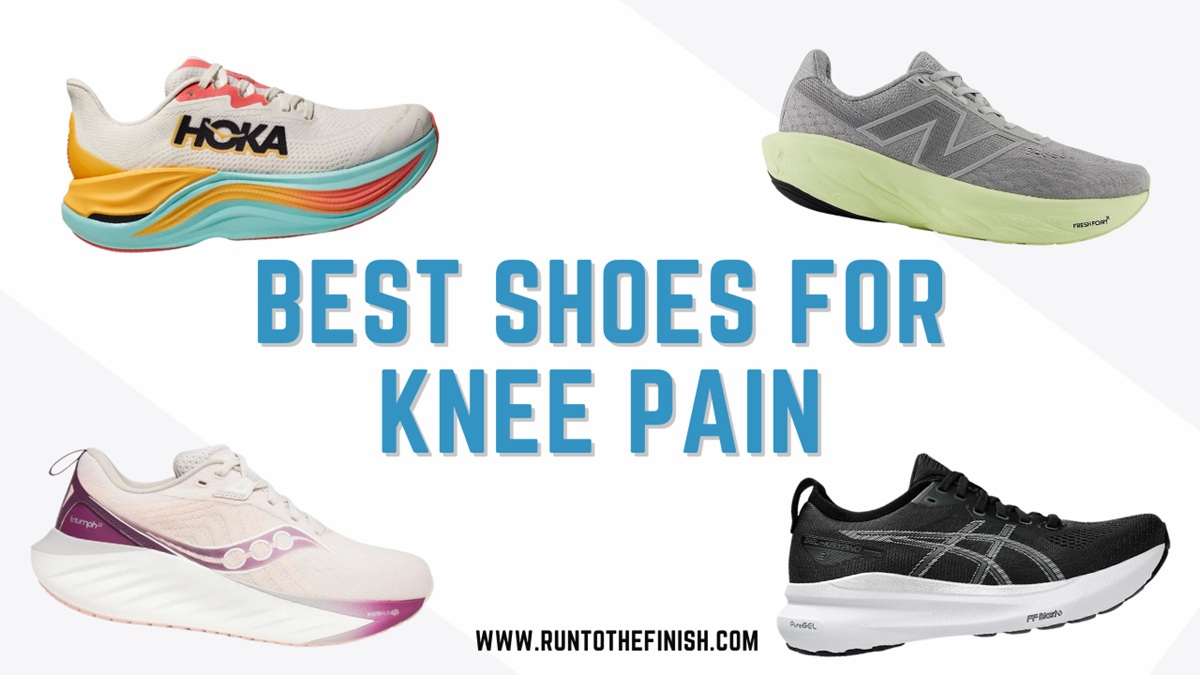
Knee pain can happen to anyone, runner or not. We all know the favorite question from non-runners is, “Don’t your knees hurt?” Or they like to say they could never run because their knees ALREADY hurt.
But the reality is, running itself is not inherently bad for our knees. Usually it’s our poor choices.
Doing too much, too quickly, wearing the wrong shoes, and weak muscles from refusing to strength train are the most common causes.
In most cases, knee pain doesn’t mean you have bad knees and it’s not permanent. It’s important to find the root cause.
However, while you’re building up your mileage or dealing with any pain, why wouldn’t we take advantage of gear to make things feel better?!
After testing literally hundreds of daily trainers, our team pulled together the best running shoes for bad knees. Stick with me as we look at some of the causes of knee pain, how much cushion may be too much, how to pick the right shoes, and my recommendations for shoes you might want to check out.
10 Best Running Shoes for Knee Pain
Below are our top picks for the best running shoes when dealing with knee pain. Remember, there are a lot of factors to consider so keep those in mind when picking a shoe. Maybe your next pair will be one of the ones reviewed below.
✅Heel drop is an important factor in knee pain shoe selection!
For the majority of people a shoe with a lower heel drop is going to help reduce the forward knee push. So 8mm to even 4mm and is ideal. That does not mean zero drop is required.
If you have poor ankle mobility or Achilles issues, then a 10mm or 12mm would be better.
And check our notes after the shoes for some additional tips to help your “bad knees” feel a whole lot better. As running coaches we just can’t let you think a shoe alone will do the work.
Best for Heavy Runners Shoe – Hoka One One Bondi 9
The Hoka One One Bondi is great for everyday running and walking. With its max cushioning, it’s almost guaranteed to provide max comfort too. The one thing to remember is that the more cushion, the less “pop” or speed you’ll get from a shoe.
I think this is really ideal for our heavier runners, those who are doing 5+ hour marathons and want some soft lasting cushion.
The newest model has a mesh construction, lighter foams, and an extended heel that offers a soft but balanced roll-through from heel strike to push-off. Just remember as we mentioned before that more cushion isn’t always better.
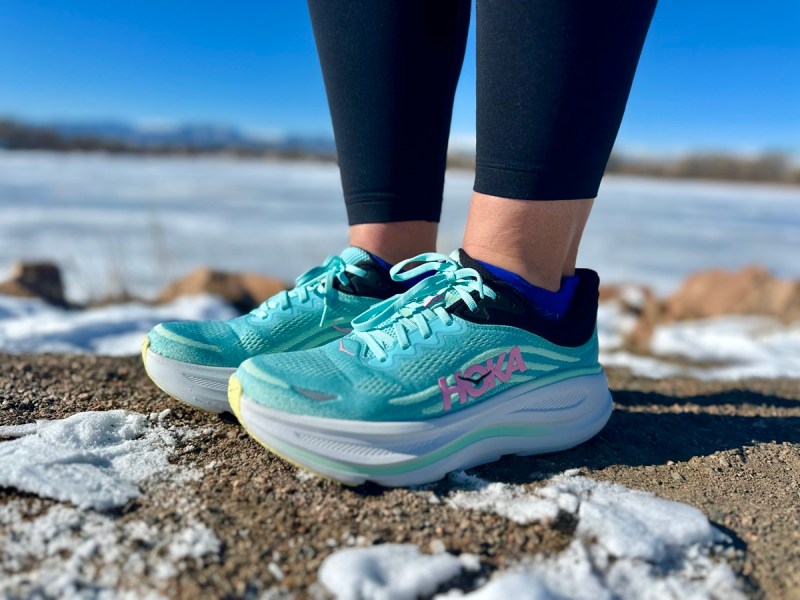
- Weight: 10.5 oz Men’s, 9.3 oz Women’s
- Heel Drop: 5 mm
- Usage: Easy runs, long runs, easily up to marathon distance
- 6 colors
- Available in wide
- Available on Hoka.com for $170
- Checkout our complete Hoka Bondi 9 review >>
Best for Wide Feet – New Balance Fresh Foam 1080 V14
Our team uses these in the regular width as a go to daily trainer, so don’t think they’re JUST for wide feet. What we like here is the 6mm heel drop prevents pushing the knee forward and the cushion is just lovely.
Coach Amanda has actually gone through 3 pairs of this shoe in the last few years.
The New Balance Fresh Foam 1080 is just a winner for our team finding it to do well for high mileage without breaking down.
We specifically noted New Balance for wide feet because you can order most shoes in a variety of widths!
Buy New Balance Fresh Foam 1080 V14
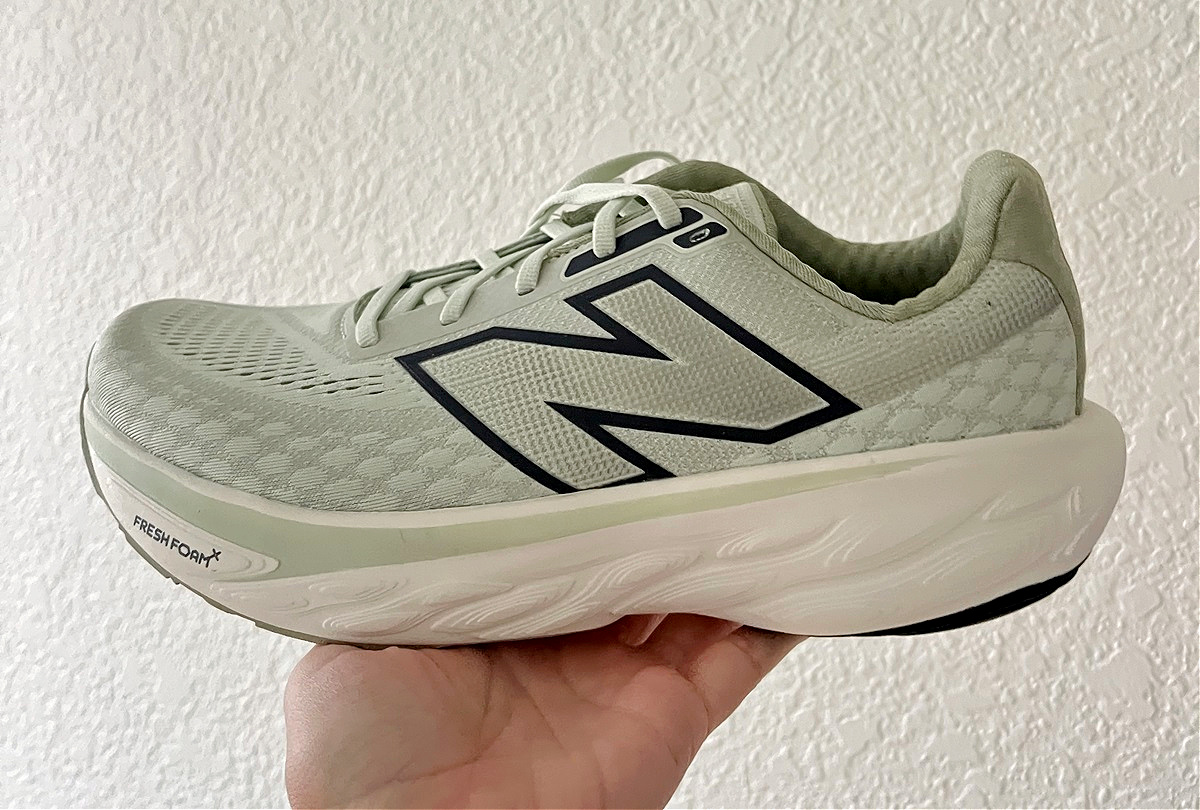
- Weight: 10.5oz Men’s, 8.3 oz Women’s
- Heel Drop: 6mm
- Usage: Easy runs, long runs, easily up to marathon distance
- 8 colors
- Available in wide and extra wide
- Available on NewBalance.com for $165
- Read our full review of the New Balance 1080 v14 >>
Best All Around Shoe – Saucony Kinvara 15
If you want 1 shoe to use for easy days, recovery days and speed days then the Kinvara has you covered.
Interestingly, one of the things I have found in myself and many other runners is that getting out of shoes in the 10-12mm heel drop range seems to help reduce IT band issues. This could be because the higher drop is pushing your knee too far forward.
That doesn’t meant you need zero drop. I really like a 4-6 mm shoe.
This has been one of my go to shoe models for nearly a decade. That being said, the Kinvara has changed over that time. It’s now a slightly more cushioned shoe with a bit more stack height (because everything seems to be increasing in stack height). It is NOT a max cushion shoe, but more of a traditional moderately cushioned fee.
It’s my easy pick for what shoe I want to put miles on during vacation because I can use it for speed or easy runs.
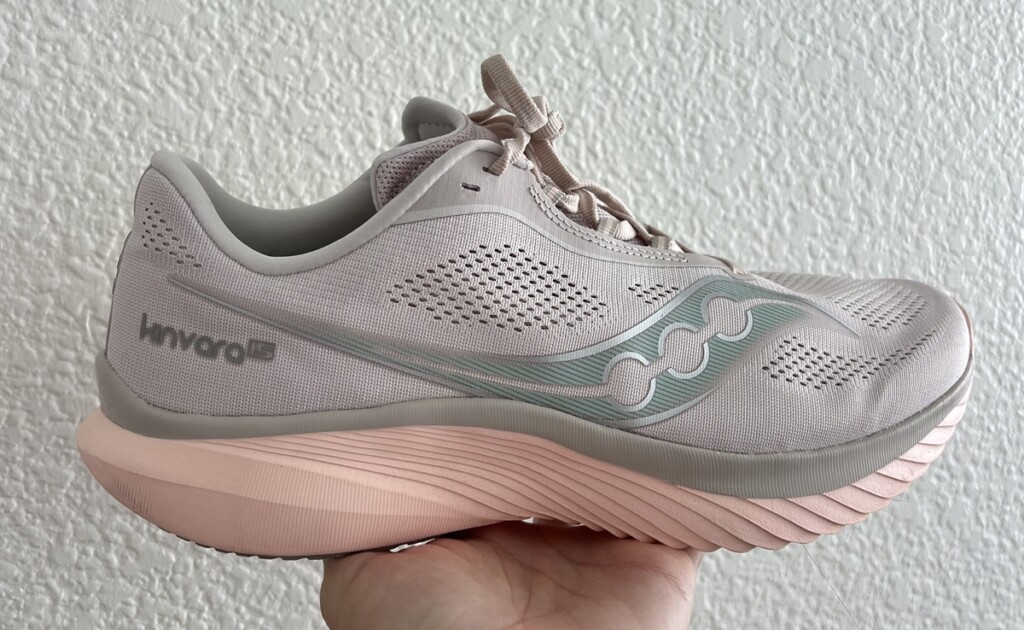
The Saucony Kinvara15 is an excellent choice for runners who are looking for a lightweight and responsive shoe that provides enough cushioning and support for longer runs.
This one has a bootie style fit, meaning that the tongue is attached. I LOVE this because it means it’s not going to be moving all over while I run.
- Weight: 6.8 oz men’s, 6.2 oz women’s
- Heel drop: 4 mm
- Usage: Easy runs, tempo work, up to half marathon distance for most
- 8 colors
- Available in wide
- Available now on Saucony.com for $120
- Read our full review of the Saucony Kinvara 15>>
Best Max Cushion Shoe – Asics Gel Nimbus 27
If you want some serious cushion to give you knees some love, then look no further.
This is a max cushion running shoe for recovery runs to long easy miles that has some bounce. While you are getting some serious stack height on this shoe it does stay at an 8mm drop which we like for your knees as well.
A reminder that more cushion doesn’t always mean better. There is some data to suggest that max cushion running shoes cause us to land with more force. Having tested hundreds of shoes with a variety of testers, we find this to be extremely individual.
What we have noticed is that because the cushion feels SO MUCH BETTER, you may end up doing more. And that could lead to discomfort if you aren’t ramping up slowly and methodically.

The midsole is still FF BLAST™ PLUS ECO cushioning, made from 24% bio-based materials to keep moving toward a goal of sustainability. I love that they are putting a carbon footprint number inside the shoe too. This is great focus to see among the brands.
- Weight: 10.7 oz Mens, 9.2 oz Women’s
- Heel Drop: 8mm
- Usage: Easy runs, long runs, easily up to marathon distance
- 4 colors
- Not available in wide
- Available at Asics.com for $160
- See our full Asics Gel Nimbus 27 review >>
Best High Drop Stability Shoe – Brooks Adrenaline GTS 24
Among stability shoes, the Brooks Adrenaline GTS is a great option. It’s been a runners favorite for more than 20 years, if that tells you anything.
This is HIGH heel drop shoe, which means it’s better for those who know they lack ankle mobility or have Achilles issues, for everyone else keep reading or we recommend the Saucony Guide!
It’s great for everyday runs or those long runs on the weekends. It has a nice solid structure with flexibility offering support for people with high arches, but can also be a solid option for flat feet with a special insert. Its GuideRails support system helps your foot move more naturally in each step.
This is going to be one of the shoes that comes in the most vibrant colors and patterns too. We had no idea just how important this was to so many of you!!

- Weight: 10 oz Men’s, 8.8 oz Women’s
- Heel Drop: 12 mm
- Usage: Stability daily trainer
- 12 colors
- Available in wide for some colors
- Available on Brooksrunning.com for $140
Best Carbon Plate Shoe – HOKA Skyward X
Previously I recommended the BondiX because it was literally designed as an ideal choice for those who will need 5+ hours to run a marathon. Luckily, they’ve replaced it with an even better shoe!
It’s bouncy, it’s fun, it gives every runner a chance to feel fast. With the Skyward X, you’re getting a little boost from the PEBA midsole foam on top of the H-Curve plate and the EVA bottom foam. YES you read it right, they’re using the high end stuff for the everyday runner and it’s so worth the price!
The wider toe box feels really wonderful as your feet swell on the run and the very slight meta rocker helps roll your foot forward. This is especially noticeable on any downhill and I loved it!
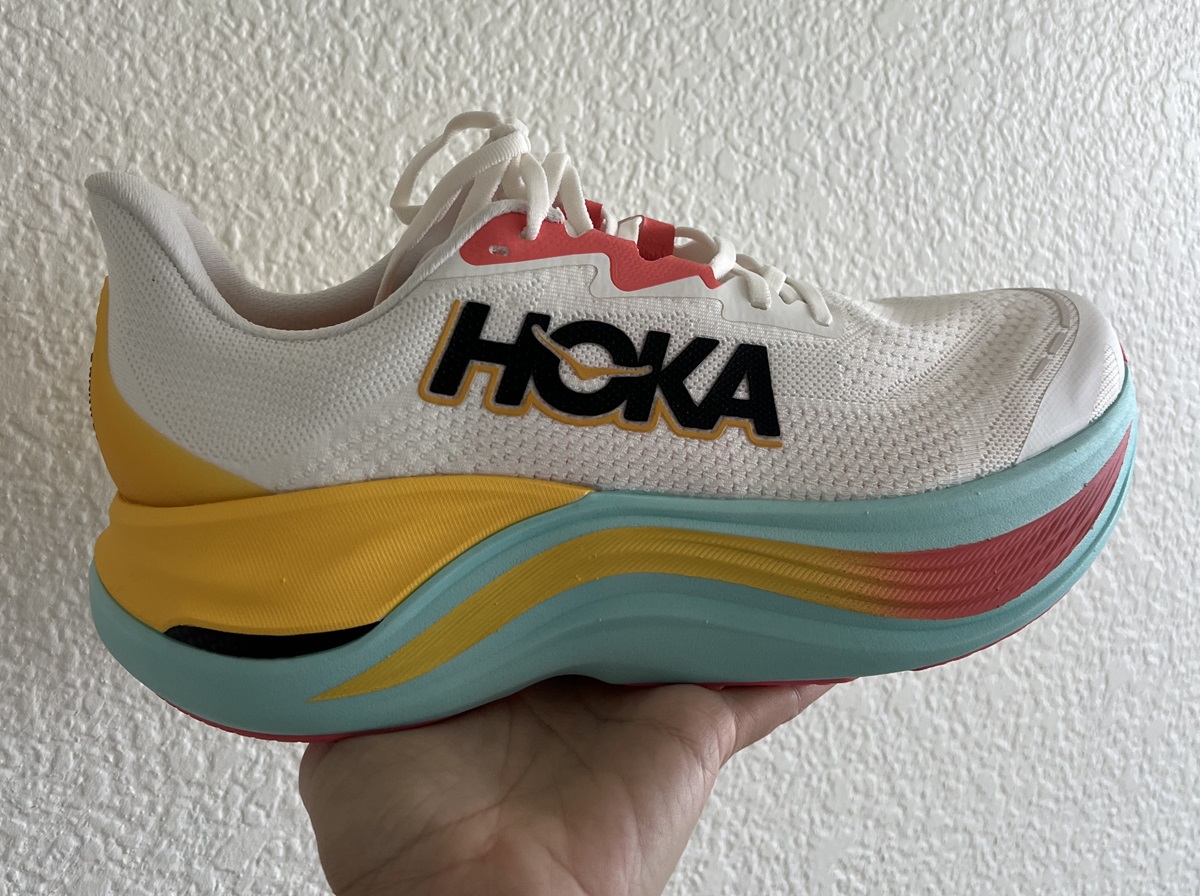
“We asked ourselves why every carbon-plated shoe on the market had to be created with an eye on only the elite runner. Everyone deserves to fly and everyone can level up.”
- Weight: 11.3 oz Men’s, 9.2 oz Women’s
- Heel Drop: 5 mm
- Usage: Long runs, Race day
- 5 colors
- Not available in wide
- Available on Hoka.com for $225
- Read our full Hoka Skyward X review >>
Best Fast Shoe (also carbon plate) – On Cloudboom Strike
After seeing Helen Obiri win Boston, a lot of runners stood up to take notice of what On was doing with carbon fiber. It’s a very different type of shoe than Nike and for a lot of runners, that’s a good thing.
This is a lower stack height and slightly higher heel drop than many of the other super shoes on the market. Compared to the Nike Vaporfly 2 or 3, it’s a 100% different fit and feeling. Where Nike feels like bouncing, this shoe mostly feels super light. And where you might hate the super high stack on the Nike, this shoe is going to feel more natural.
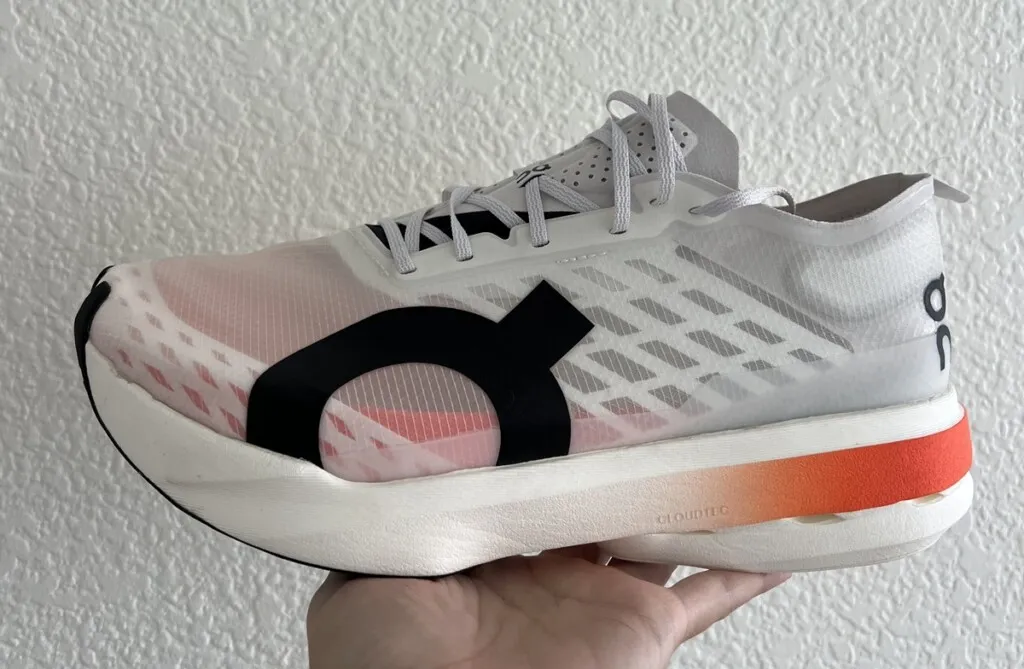
- Heel Drop: 4 mm
- Weight: 6.8 oz women’s and 7.7 oz men’s
- Usage: Fast, race day, up to marathon shoe
- Available in 2 colors
- Not available in wide
- Available at On Running for $280
- Detailed review of the On Cloudboom Strike >>
Best Wide Toe Box Option – Topo Cyclone
We are NOT against zero drop shoes. But if you’re currently running in something higher and want a toe box with more room, we really like this 4mm drop from Topo.
If you haven’t tried a Topo Athletic shoe before, the brand is known in the running shoe world for their shoes’ anatomical toe box . This basically means that the shoe’s tox box doesn’t come to a point like a lot of traditional running shoes and stays wider to accommodate your forefoot width.
The stack height is coming in around 28mm like some of the old school shoes! It just means that you’re going to be able to feel the ground a little more but still have some protection.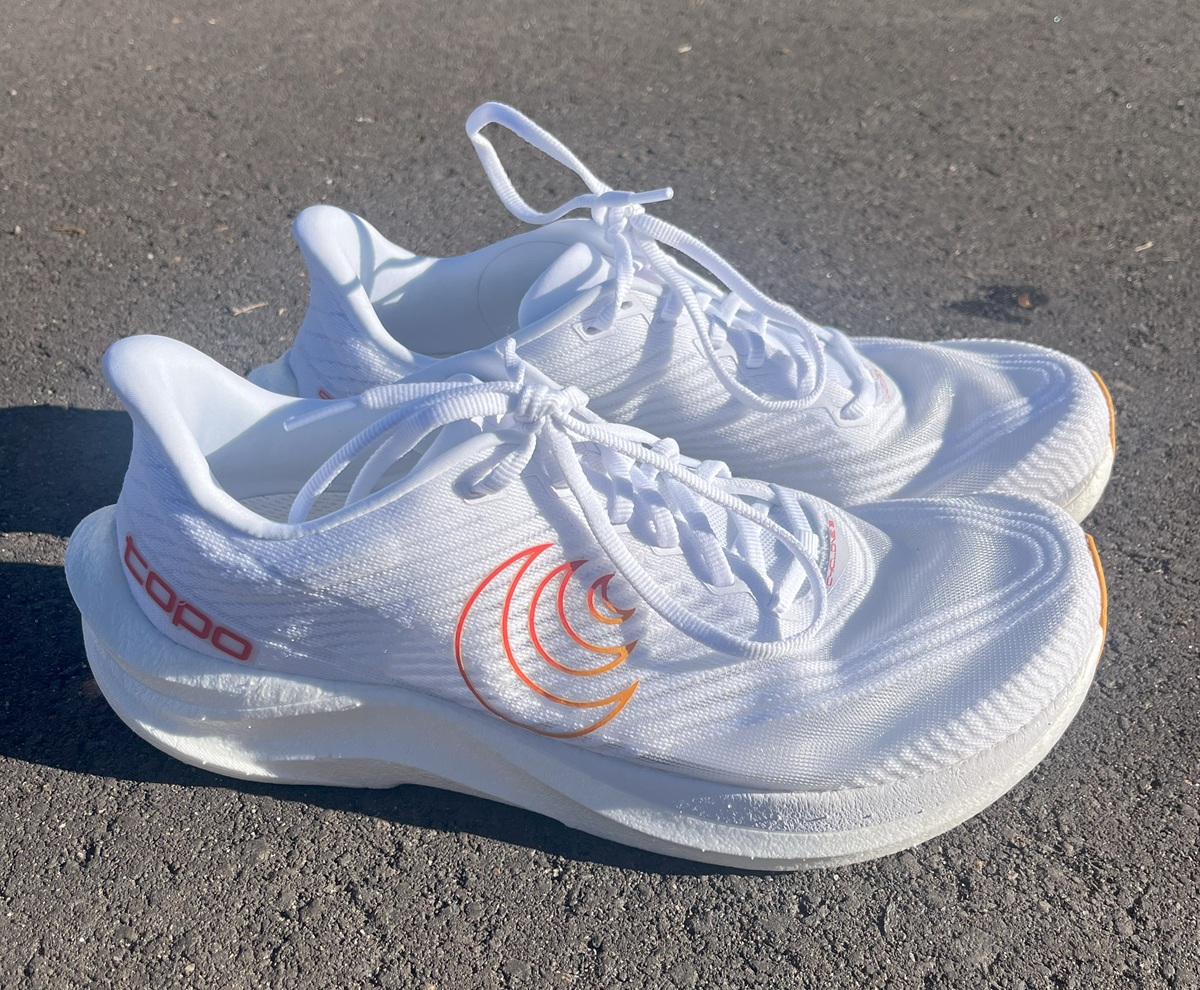 We actually think this brand is really undervalued. Every shoe our team has tested comes back with glowing reviews and is a reminder that you can get some really feel good cushion without a super high stack.
We actually think this brand is really undervalued. Every shoe our team has tested comes back with glowing reviews and is a reminder that you can get some really feel good cushion without a super high stack.
- Weight: 6.9oz Men’s, 5.5 oz Women’s
- Heel drop: 5mm
- Available in 2 colors
- Not available in wide
- Available at REI for $150
- Check out our full review of the Topo Cyclone 3 here >>
Best for Road to Trail – Hoka Challenger 7
The Hoka Challenger is an all-terrain shoe allowing you to go from street to trails without a hitch. While not as cushy as its sibling the Bondi, its padding provides the shock absorption you need while remaining light enough for the demands of trail running.
Again this isn’t not a stability shoe, but by default HOKA shoes provide more stability than most.
The sole boasts 4mm lugs ensuring good grip on the trails, but they’re small enough that they won’t feel wonky on the road.
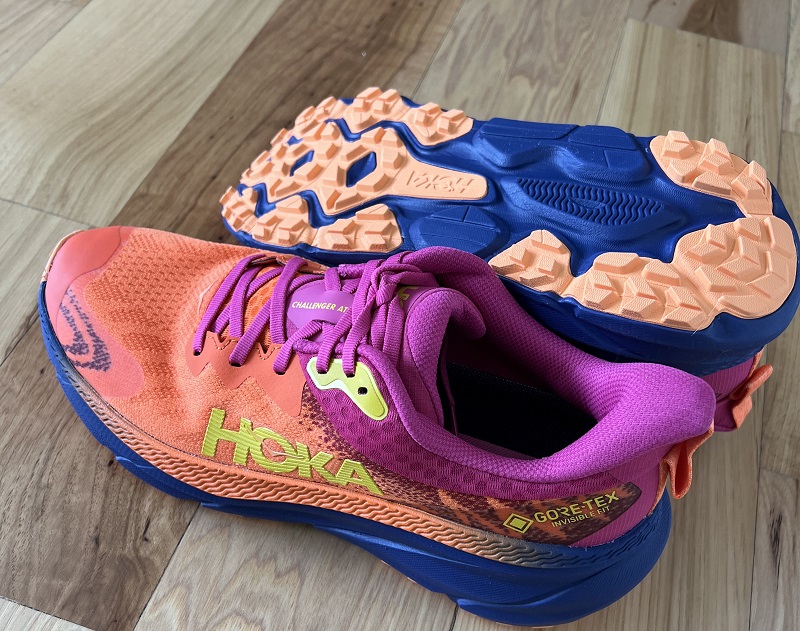
- Weight: 8.9 oz Men’s, 7.7 oz Women’s
- Heel Drop: 5 mm
- Usage: Road to trail, easy runs, long runs
- 15 colors
- Available in wide
- Available on Hoka.com for $145
How to Find the Right Shoes for Knee Pain
Shoes aren’t cheap and while you can often return them if they aren’t the right shoe for you, you don’t want to have to do that numerous times because changing shoes is simply masking the problem and not solving it.
Once you’ve determined the cause of your knee pain and a solution, it’s time to find appropriate shoes. You want to consider a number of factors, including your feet and arches, comfort, support, cushion, materials used, and sizing options.
Why Do Your Knees Hurt While Running?
I’ve done a huge article on 7 causes of knee pain while running to help you see exactly what might be happening and resolve it. But for a quick overview:
- Weak hips and glutes. They may not be able to help you maintain proper alignment. You’ll first need to strengthen those muscles to help you maintain proper alignment when running.
- Overstriding. You may be reaching when you run with your feet landing in front of your body. Take a look at your overall form and see what areas may need improvement.
- Overpronation. Your feet are rolling inward.
- Supination. Your feet are rolling outward.
- Wrong running shoe fit. Yes, you may be in the wrong shoes for your body and feet
- Worn out shoes. Wearing shoes that have seen too many miles means the shoe is broken down and breaks down your form.
It’s important that you determine the cause of your knee pain before going any further.
The sheer amount of trainers on the market these days can make shoe shopping overwhelming, especially when trying to deal with a specific issue such as knee pain. Obviously, this isn’t an all-encompassing list, but hopefully it provides you with, at the very least, a place to start your search.
Looking for more running shoe guides?
For more help selecting the right shoe for you, don’t worry, I’ve got you:
- How to Choose Running Shoes
- Best Running Shoes for Flat Feet
- Best Running Shoes for Wide Feet
- HOKA vs Nike
- ASICS vs Brooks
- Best Long Distance Running Shoes
Other ways to connect with Amanda
Instagram Daily Fun: RunToTheFinish
Facebook Community Chatter: RunToTheFinish
Sign Up to Receive a Weekly Newsletter with Top Running Tips and Laughs



 Suunto Vs Polar | Comparing Features and Models
Suunto Vs Polar | Comparing Features and Models